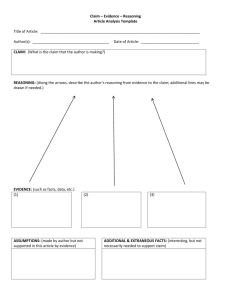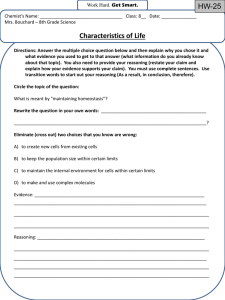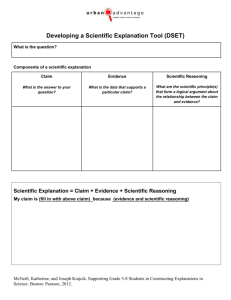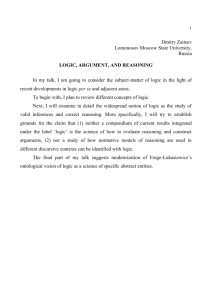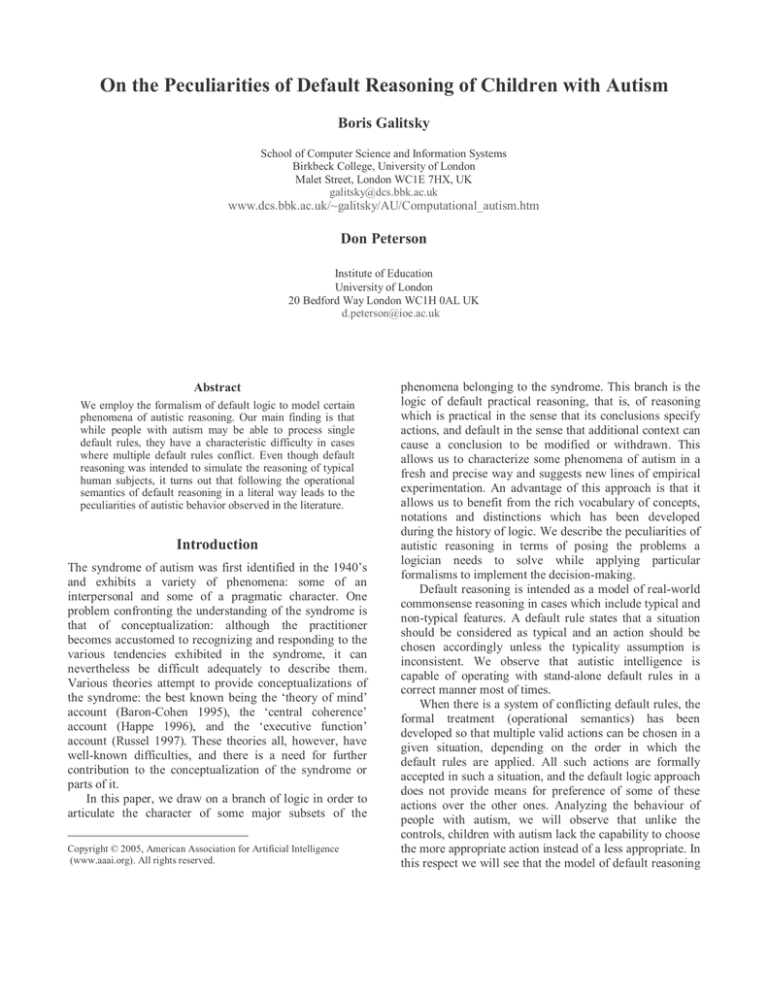
On the Peculiarities of Default Reasoning of Children with Autism
Boris Galitsky
School of Computer Science and Information Systems
Birkbeck College, University of London
Malet Street, London WC1E 7HX, UK
galitsky@dcs.bbk.ac.uk
www.dcs.bbk.ac.uk/~galitsky/AU/Computational_autism.htm
Don Peterson
Institute of Education
University of London
20 Bedford Way London WC1H 0AL UK
d.peterson@ioe.ac.uk
Abstract
We employ the formalism of default logic to model certain
phenomena of autistic reasoning. Our main finding is that
while people with autism may be able to process single
default rules, they have a characteristic difficulty in cases
where multiple default rules conflict. Even though default
reasoning was intended to simulate the reasoning of typical
human subjects, it turns out that following the operational
semantics of default reasoning in a literal way leads to the
peculiarities of autistic behavior observed in the literature.
Introduction
The syndrome of autism was first identified in the 1940’s
and exhibits a variety of phenomena: some of an
interpersonal and some of a pragmatic character. One
problem confronting the understanding of the syndrome is
that of conceptualization: although the practitioner
becomes accustomed to recognizing and responding to the
various tendencies exhibited in the syndrome, it can
nevertheless be difficult adequately to describe them.
Various theories attempt to provide conceptualizations of
the syndrome: the best known being the ‘theory of mind’
account (Baron-Cohen 1995), the ‘central coherence’
account (Happe 1996), and the ‘executive function’
account (Russel 1997). These theories all, however, have
well-known difficulties, and there is a need for further
contribution to the conceptualization of the syndrome or
parts of it.
In this paper, we draw on a branch of logic in order to
articulate the character of some major subsets of the
Copyright © 2005, American Association for Artificial Intelligence
(www.aaai.org). All rights reserved.
phenomena belonging to the syndrome. This branch is the
logic of default practical reasoning, that is, of reasoning
which is practical in the sense that its conclusions specify
actions, and default in the sense that additional context can
cause a conclusion to be modified or withdrawn. This
allows us to characterize some phenomena of autism in a
fresh and precise way and suggests new lines of empirical
experimentation. An advantage of this approach is that it
allows us to benefit from the rich vocabulary of concepts,
notations and distinctions which has been developed
during the history of logic. We describe the peculiarities of
autistic reasoning in terms of posing the problems a
logician needs to solve while applying particular
formalisms to implement the decision-making.
Default reasoning is intended as a model of real-world
commonsense reasoning in cases which include typical and
non-typical features. A default rule states that a situation
should be considered as typical and an action should be
chosen accordingly unless the typicality assumption is
inconsistent. We observe that autistic intelligence is
capable of operating with stand-alone default rules in a
correct manner most of times.
When there is a system of conflicting default rules, the
formal treatment (operational semantics) has been
developed so that multiple valid actions can be chosen in a
given situation, depending on the order in which the
default rules are applied. All such actions are formally
accepted in such a situation, and the default logic approach
does not provide means for preference of some of these
actions over the other ones. Analyzing the behaviour of
people with autism, we will observe that unlike the
controls, children with autism lack the capability to choose
the more appropriate action instead of a less appropriate. In
this respect we will see that the model of default reasoning
suits autistic subjects better than controls.
This study branches out of our earlier studies of
counterfactual reasoning (Peterson and Bowler 2000,
Peterson et al 2004) and reasoning about mental states of
autistic patients (Galitsky 2002), and extends the lines of
our existing rehabilitation strategies (Galitsky 2003a).
Characterizing autistic reasoning
In this study we argue that the inability to use default rules
properly leads to certain phenomena of autistic reasoning
identified in the experimental studies (e.g. Happe 1996,
Russel 1997, Pilowsky et al 2000):
1. Non-toleration of novelty of any sort;
2. Incapability to change plan online when
necessary;
3. Easy deviation from a reasoning context, caused
by an insignificant detail;
4. Lack of capability to distinguish more important
from less important features for a given situation;
5. Inability to properly perceive the level of
generality of a feature appropriate for a given
situation,
Note that these peculiarities of reasoning can be
distinguished from reasoning about mental attitudes, which
are usually corrupted in a higher degree in case of autism
(Baron-Cohen 1995).
Our approach considers the mechanisms of how typical
reasoning is performed from the computational
prospective, and then compares these mechanisms with the
limitations of experimentally observed autistic reasoning.
We take advantage of significant achievements of logical
artificial intelligence in modelling human reasoning and
understanding the mechanisms of solving the problems
suggested to autistic and controls during the experiments.
This computational approach therefore complements the
findings of psychological experimentation in the study of
autism.
Default reasoning is a particular machinery intended to
simulate how human reasoning handles typical and
atypical features and situations. Apart from reasoning
about mental attitudes which is essential in presenting
autism, we apply default reasoning to conceptualize a wide
range of phenomena of autistic reasoning, taking advantage
of the experience of computer implementation of default
reasoning. Peculiarities of autistic reasoning can then be
matched against the known possibilities of malfunctioning
of artificial default reasoning systems.
In the context of artificial intelligence, the phenomena of
autistic reasoning are of particular interest, since they help
us to locate the actual significance of formal models of
default reasoning. At the same time, we expect this study
to shed light on how autistic reasoning may be improved
by default reasoning-based rehabilitation techniques.
Handling a single default rule by autistic
reasoning
An abstract default logic distinguishes between two kinds
of knowledge: the usual formulas of predicate logic
(axioms, facts) and “rules of thumb” (defaults, see
Antoniou 1997). Corrupted reasoning may handle
improperly either kind of knowledge, and we pose the
question which kind may function improperly in autistic
reasoning. Moreover, we consider the possibility that an
improper interaction between the facts and rules of thumb
may be a cause for corrupted reasoning.
Default theory (Brewka et al 1995, Bochman 2001)
includes a set of facts which represent certain, but usually
incomplete, information about the world; and a set of
defaults which cause plausible but not necessarily true
conclusions (for example, because of the lack of a world
knowledge or a particular situation-specific knowledge). In
the course of routine thinking of human and automatic
agents some of these conclusions have to be revised when
additional context information becomes available.
Let us consider the traditional example quoted in the
literature on nonmonotonic reasoning:
bird(X): fly(X)
fly(X)
One reads it as If X is a bird and it is consistent to assume
that X flies, then conclude that X flies. In the real life, if
one sees a bird, she assumes that it flies as long as no
exceptions can be observed.
fly(X):- not penguin(X). fly(X):- not sick(X).
fly(X):- not just_born(X). …
Exceptions are the potentially extensive list of clauses
implying that X does not fly. It would be inefficient to start
reasoning based on exceptions; it should be first assumed
that there are no exceptions, then verified that this is true
and then proceed to the consequent of a default rule.
A penguin (the bird which does not fly) is a novelty (it
is atypical). Conventional reasoning first assumes that
there are no novelties (there is no exception) and then
performs the reasoning step, concluding that X flies. If this
assumption is wrong (e.g. X-novelty is taking place) then
the rule is inapplicable for penguins and it cannot be
deduced that X flies. It is quite hard for autistic reasoning
to update this kind of belief because it handles typical and
atypical situations in the same manner, unlike the default
rule machinery suggests. It is quite computationally
expensive to handle typical and atypical situations
similarly, because a typical situation is compact and most
likely to occur, and an atypical situation comprises an
extensive set of cases (clauses) each of which is unlikely to
occur.
Let us now view this example from the perspectives of
five phenomena mentioned above:
Unlike normal subjects, and similar to software systems,
autistic
subjects
can
hardly
tolerate
the
Additional_features_of_envir_do_not_change_routine
when they have a Usual_intention to
Follow_usual_routine:
Usual_intention :
Additional_features_of_envir_do_not_change_routine
Follow_usual_routine
This default rule schema is read as follows: when there is a
Usual_intention, and the assumption that
Additional_features_of_envir_do_not_change_routine is
consistent, then it is OK to Follow_usual_routine. There
should be clauses specifying the situations where this
assumption fails:
Additional_features_of_envir_not_change_routine:- not (
alarm(fire) ∨ desire(DoSometrhingElse) ∨… ).
This clause (assumption) fails because of either external
reasons or internal ones, and the list of potential reasons is
rather long.
A child knows that birds fly. The child sees observes that
penguins do not fly
Child updates the list of
Child adds new rule that
exceptions for not
penguins do not fly
property flies
The flying default rules
It is necessary to update the
stays intact.
existing rule of flying and all
the rest of affected rules
The process of accepting
This process takes substantial
new exceptions is not
computational efforts and,
computationally
therefore, is quite undesirable
expensive
and overloading.
Observing a novelty and
Observing a novelty is
remembering exceptions
stressful
is a routine activity
A good example here is that the autistic child runs into
tremendous problems under deviation in an external
environment which typical cognition would consider to be
insignificant.
We proceed to the phenomenon of Incapability to
change a plan online when necessary. A characteristic
example is that of an autistic child who does not walk
around a puddle which is blocking her customary route to
school, but rather walks through it and gets wet as a result.
This happens not because the autistic child does not know
that she would get wet stepping through a puddle, but
because the underlying reasoning for puddle avoidance is
not integrated into the process of reasoning. Let us
consider the reasoning steps a default system needs to
come through.
Initial plan to follow a certain path is subject to
application (verification) by the following default rule:
need(Child, cross(Child, Area)) : normal(Area)
cross(Child, Area)
abnormal(Area) :- wet(Area) v muddy(Area) v
dangerous(Area).
Here we consider a general case of an arbitrary area to
pass by, Area=puddle in our example above. The rule
sounds as follows: “If it is necessary to go across an area,
and it is consistent to assume that it is normal (there is
nothing abnormal there, including water, mud, danger etc.)
then go ahead and do it). A control individual would apply
the default rule and associated clause above to choose her
action, if the Area is normal. Otherwise, the companion
default rule below is to be applied and alternative
AreaNearBy is chosen.
need(Child, cross(Child, Area)), abnormal(Area) :
normal(AreaNearBy)
cross(Child, AreaNearBy)
Note that formally one needs a similar default rule for
the case something is wrong with AreaNearBy:
abnormal(AreaNearBy). A control individual ignores it to
make a decision with reasonable time and efforts; on the
contrary, autistic child keeps applying the default rules,
finds herself in a loop, gives up and goes across the puddle.
In other words, autistic reasoning literally propagates
through the totality of relevant default rules and run into
the memory/operations overflow whereas a normal human
reasoning stops after the first or second rule is applied.
What are the peculiarities of how autistic children apply
a newly acquired rule? First of all, they do their best in
applying it, however, they follow it literally. Let us
consider the following example:
An autistic girl was advised by her parents not to speak
with strangers in the street. On one occasion a policeman
approached the girl and started asking questions, but was
ignored by her. In spite of his multiple attempts to encourage
the girl to communicate, they failed and he became upset.
After the parents were told about the incident they
suggested that the girl should not have treated policemen as
a stranger. They also confirmed that the girl new who
policemen were. The girl required that she needed the new
explicit rule overwriting the initial one that a policeman was
not a typical stranger and should have been treated
differently.
On the basis of the analysis presented here, this anecdote
could be given the following interpretation:
1. The subject is doing her best to follow the rule, and
readily accepts new rules
2. The girl did know that the approaching man was a
policeman, but she did not know him as a person,
therefore she categorised him as a stranger in the
context of the behavioural rule.
3. In this situation the girl was familiar with who
policemen are, as she knew that policemen should not
be ignored.
4.
However, she was not able to handle a policeman as
an exception in the rule for stranger.
5. If she had had the explicit rule for how to respond to
strangers who are policemen then she would have
followed it.
We conjecture that the girl had sufficient knowledge of
the subject and was capable of applying the rules, taken
separately. What she was not able of doing was to resolve
a conflict between considering the same individual as a
stranger and as a policemen in the context of decision
whether to communicate or to ignore.
in_street(me) :- stranger(Person)
not talk(me, Person)
Usually, strangers do not fall into a special category;
however, exceptions are possible:
stranger(Person):-not (policeman(Person) ∨
rescue(Person) ∨ military(Person ∨…).
Indeed, the girl is likely capable of identifying the
categories of persons above. However, it is not the case in
the above context of a stranger rule, which is indeed an
opposing rule to the one for handling exceptions:
talk(me, Person):- not (Person).
If the parent would incorporate the rule above into the
default rule explicitly, then it is likely that the girl would
treat the policemen properly.
contradicting each other or, a consequent of one rule can
contradict the justification of another one. In order to
provide an accurate solution we have to introduce the
notion of extensions: current knowledge bases, satisfying
some specific conditions.
Suppose D is a set of defaults and W is a set of facts
(our initial knowledge base). Let ∆ be an ordered subset
of D without multiple occurrences (it is useless to apply
the default twice because it would add no information).
We denote a deductive closure (in terms of classical
logic) of ∆ by In(∆): W ∪ {cons(δ)δ∈∆}. We also
denote by Out(∆) the set {¬ψψ ∈ just(δ), δ∈∆}. We
call ∆={δ0, δ1,…}a process iff for every k δk is applicable
to In(∆k), where ∆k is the initial part of ∆ of the length k.
Given a process ∆, we can determine whether it is
successful and closed. A process ∆ is called successful iff
In(∆)∩Out(∆) = ∅ . A process ∆ is called closed if ∆
already contains all the defaults from D, applicable to
In(∆).
Now we can define extensions. A set of formulae
E⊃W is an extension of the default theory <D, W> iff
there is some process ∆ so that it is successful, closed,
and E=In(∆).
Let us consider an example of a lost toy; a child
needs to decide on which action to choose. Let us suppose
that W is empty and D is the set of
true : not toy_lost(X)
Handling conflicting default rules
δ1
In this section we proceed to the situation where there are
multiple (conflicting) default rules, and the results of their
execution depend on the order these rules are applied. Here
we propose an informal description for such situations,
introducing operational semantics for default reasoning.
The main goal of applying default rules is to make all
the possible conclusions from the given set of facts. This is
the bottleneck for autistic reasoning: a child may come to a
single conclusion without being aware than other solutions
may be as valid. A control subject is usually capable of
identifying the totality of conclusions and of applying
some kind of preference criteria to select a more
appropriate one. Presenting the operational semantics, we
bear in mind that in contrast to controls, autistic reasoning
follows it literally. Following the operational semantics of
default reasoning in case of conflicting rules provides
conclusions similar to what autistic subjects produce,
because both lack the machinery to apply preference and
select a more adequate solutions, taking into account
circumstances which are neither expressed by facts nor
rules in the default system.
What is the nature of conflict under operational
semantics? If one applies only one default, we can simply
add its consequent to our knowledge base. The situation
becomes more complicated if we have a set of defaults
because, for example, the rules can have consequents
δ2
not toy_lost(X)
true : toy_lost(X)
search(X, toy_lost)
These rules describe a situation when children toys are
normally not assumed to be lost if not immediately seen,
but, if it’s consistent to assume that the toy has been taken
by someone, then it is worth searching for.
After we have applied the first rule, we extend our
knowledge base by not toy_lost(X):
In({δ1}) = { not toy_lost(X) },
Out({δ1}) = { toy_lost(X) }.
The second rule is not applicable to In({δ1}). Therefore
the process ∆ ={δ1} is closed. It is also successful, so
In({δ1}) is an extension. Suppose now we now apply δ1
first:
In({δ2 }) = { search(X, toy_lost) },
Out({δ2 }) = { not toy_lost(X) }.
The rule δ1 is still applicable now, so {δ2} process is not
closed. Let us apply δ1 to In({δ2 }):
In({δ2,δ1}) = { search(X, toy_lost), not toy_lost(X) },
Out({δ2,δ1}) = { not toy_lost(X), toy_lost(X) }.
Now In({δ2,δ1 }) ∩ Out({δ2,δ1 })≠∅ so {δ2, δ1} is not
successful and { search(X, toy_lost), not toy_lost(X) } is
not an extension. This comes in accordance with our
intuitive expectations, because if we accept the later
statement to be a possible knowledge base, then we
conjecture that the toy will be searched always, not only
when we suspect that it has been taken by someone.
However, if there are two extensions (possibilities for
actions), then more than one action are deemed formally
legitimate. In a real life situation normal individuals, unlike
autistic ones, possess additional machinery to select
appropriate actions. On the contrary, autistic children, if
capable of using default rule, follow the above
methodology literally. They therefore may choose an
action inadequate from the perspective of control subjects,
but nevertheless correct from the perspective of formal
default reasoning.
Due to literal following of the operational semantics,
autistic children have significant difficulties understanding
natural language sentences and reacting to commands
including multiple ambiguous words. Analyzing
combinations of meaning, autistic reasoning may produce
formally valid but inadequate (from the viewpoint of
control subjects) representations.
We conclude this section by the training example we
have been using in the autistic rehabilitation Center “Sunny
World” (Moscow, Russia). The exercise teaches autistic
children to operate with multiple possible interpretations of
natural language expressions. Indeed, autistic children have
problems understanding situations where there are multiple
ambiguous words in a query and the totality of overall
meaning for a sentence is a combination of meanings of
these words. Let us consider the following expression (in
Russian):
“Эта картина заставила его забыть о своем
состоянии”
The first ambiguous word, картина, has two following
meanings:
1.1) A work of art, a painting;
1.2) A set of events observable at a certain time.
The meanings of the second word, состояние
(normalized), are:
2.1) Monetary assets of an individual;
2.2) Mental and physical state of an individual.
The respective default theory has four extensions with the
following meanings:
1.1-2.1) This painting made him forgot about his
poverty/wealth;
1.2-2.1) This accident made him forgot about how
poor/rich he was;
1.1-2.2) This painting made him ignore his feeling unwell;
1.2-2.2) This accident distracted him from his thoughts.
The children are demonstrated that all above meaning are
valid; however, some of them are more appropriate than
others in a certain context. This is also the case under
disambiguation for question answering (Galitsky 2003b).
An easier training example which was attempted by
more than 10 children with autism is depicted at Fig. 1.
The focus of this exercise is to develop the capability of
changing plans online. The user interface represents a
decision-making procedure in changing environment via
list boxes.
Conclusions
This paper has drawn on a branch of logic in order to
provide a framework for the understanding of the elusive
phenomena of autistic reasoning. Our thesis is that
difficulty arises in autism specifically in those situations
where two default rules conflict, and this provides a
relatively precise tool for understanding some of the
phenomena of autism. This will be a basis for our further
work which will investigate the following conjectures:
1. Non-toleration of novelty of any sort, because it
requires update of the whole commonsense
knowledge, since it is not adequately divided into
typical and atypical cases, norms and exceptions;
2. Incapability to change plan online when necessary,
because it requires substantial computational efforts to
exhaustively search the space of all possibilities;
3. Easy deviation from a reasoning context, caused by an
insignificant detail, because there is a high number of
issues to address at each reasoning step; each such
issue is seemed to be plausible;
4. Lack of capability to distinguish more important from
less important features for given situation, because
feature importance is mainly measured in the context
of being a justification of default rule.
5. Inability to properly perceive the level of generality of
features appropriate for a given situation is due to the
problem of estimating which generality of a given
feature is most typical, and which is less typical to be
applied as a justification of a default rule.
We observed that loss of reasoning efficiency due to
improper use of default rules leads to a wide range of
reasoning problems reflected in behavioral characteristics
of autistic subjects.
Finally, we mention the methodology for experimental
testing of our hypothesis that inability of applying default
rules leads to a series of significant deviations of reasoning
capabilities in autism. A typical situation where a default
rule is naturally applied arises while understanding an
ambiguous sentence (command), where one meaning is
typical and another is atypical. Conducting a conversation
with an autistic individual, an experimenter may ask
ambiguous questions or give ambiguous commands, and
track the reactions of the patient. Five phenomena of this
study can be addressed in such a scenario, and observed in
terms of how handling ambiguity via default rules
influences these phenomena. We have conducted
preliminary experiments along this line, and more detailed
experimental observations of this sort are the subject of our
further study.
Planning actions
2
2
2
3
Serving dinner
Your friends are visiting you. You are serving a dinner. Now your guests are almost done eating
the main course. You are being asked to pick up plates...
2
Pick up plates
2
1 eating
The guest keeps
2
Wait till guests are done eating
Pick up the plate first and then offer more food
The guest is done eating and askes for more food. There are food remains in the plate.
3
1
1
On my way to school
You are on your way to school. It rains today, so there is paddle in the area which is usually dry.
Besides, there are other complications on your way...
I am on my4usual way to school
There is a paddle on the way
Not enough space to go around
My shoose are very expensive
Nothing special on my way back
1
1
2
Go around the paddle
2
2
1
3
2
2
Go straight
1
Turn back
Turn back
2
3
3
.m mnnnnm , ]\;ln.рзюрзззььдль ььддьдььз -хноо о оои б б ь бббьбббббюб0,.эээээээээээээээээээ
Fig. 1 The screen-shot of the interactive form for the
rehabilitation of autistic reasoning.
References
Antoniou, G. 1997. Nonmonotonic reasoning. MIT Press
Cambridge, MA London England.
Baron-Cohen, S. 1995. Mindblindness: An Essay on Autism
and Theory of Mind. Cambridge, Massachusetts: MIT Press.
Bratman, M.E.: Intention, plans and practical reason. Harvard
University Press: Cambridge MA (1987).
Brewka, G., Dix, J., Konolige, K. 1995. Nonmonotonic
reasoning: an overview. CSLI Lecture Notes 73.
Bochman, A. 2001. A logical theory of Nonmonotonic
Inference and Belief Change. Springer Verlag.
Galitsky, B. 2003a. Using mental simulator for emotional
rehabilitation of autistic patients. St. Augustine, FL.
Galitsky, B. 2003b. Natural Language Question Answering
System: Technique of Semantic Headers. Advanced Knowledge
International, Australia.
Galitsky, B. 2002. Extending the BDI model to accelerate the
mental development of autistic patients. Second Intl. Conf. on
Development & Learning. Cambridge, MA.
Happe, F.G. 1996. Studying weak central coherence at low
levels: children with autism do not succumb to visual illusions. A
research note. J. Child Psychol Psychiatry. Oct;37(7):873-7 .
Peterson, D.M and Bowler, D.M. 2000. Counterfactual
reasoning and false belief understanding in children with autism.
Autism: The International Journal of Research and Practice 4(4):
391-405. (2000).
Russel, J. 1997. Ed. Autism as an Executive Disorder Oxford
Univ. Press.
Peterson, D., Galitsky, B. and Goldberg, S. 2004. Literal
handling of conflicting default rules leads to inadequate reactions
of autistic patients. Seventh Intl. Conference of Cognitive and
Neural Systems, Boston MA.
Pilowsky T., Yirmiya N., Arbelle S. and Mozes T. 2000.
Theory of mind abilities of children with schizophrenia, children
with autism, and normally developing children. Schizophr Res.
Apr 7;42(2):145-55.

